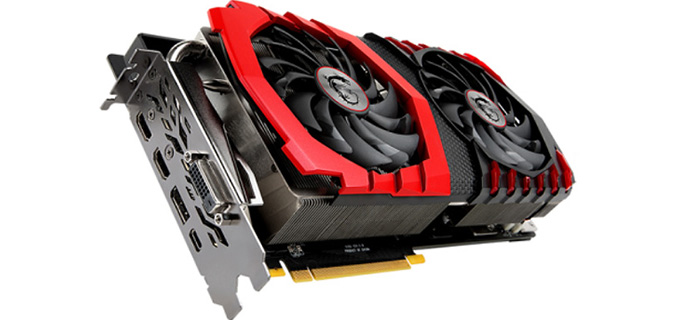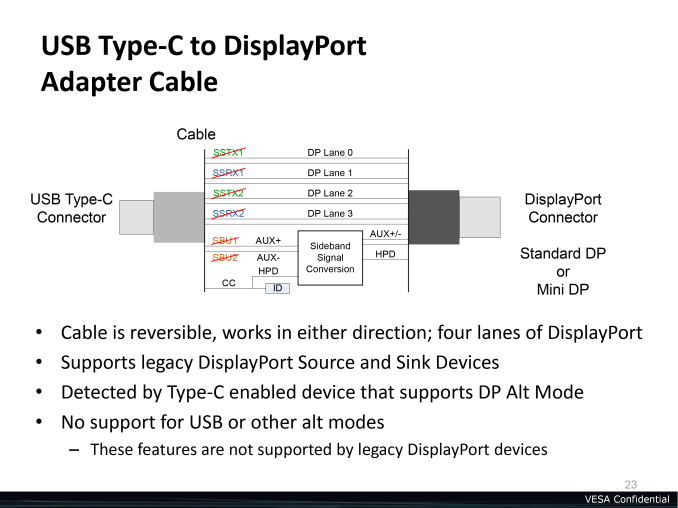MSI Shows Off GeForce GTX 1080 Ti Gaming X Card with USB Type-C Port
by Ryan Smith on June 4, 2017 4:00 PM EST- Posted in
- GPUs
- MSI
- DisplayPort
- USB-C
- Computex 2017

Back when the VESA announced the DisplayPort alt mode for USB Type-C, one of the most common questions was whether we’d see USB ports on a video card. As a standards body the VESA couldn’t answer this question, but ultimately whether that would happen would be up to the manufacturers. Now at Computex, MSI is showing off what looks to be the first high-end video card with a USB-C port for display purposes: the MSI GTX 1080 Ti GAMING X 11G Graphics Card with USB Type C.
The USB-C equipped card is virtually identical to its regular GTX 1080 Ti GAMING X 11G counterpart, except dropping the final DisplayPort for the USB-C port, leaving it with 2 DisplayPorts, a DVI-D port, an HDMI port, and the USB-C port. From a feature perspective, thanks to DisplayPort alt mode, a USB-C port is just as good as a DisplayPort for DP signaling purposes (though it should be noted that you lose TMDS backwards compatibility), which means the switch to a USB-C port doesn’t cost anything, but it also doesn’t necessarily gain anything.
What MSI isn’t commenting on right now is whether this USB-C port will offer anything besides DisplayPort alt mode functionality, such as USB 2.0 data another alt mode. The USB-C alt mode standard requires that the 4 USB 2.0 pins remain untouched, but strictly speaking they don’t seem to be necessary for alt mode to work since that’s handled by the CC pins. However DisplayPort monitors using USB-C for all of their connectivity, such as the LG UltraFine 21.5, will not appreciate the lack of USB data. In which case USB 2.0 data is required for maximum compatibility.
Ultimately, placing a USB-C port on a high-end video card serves a few different purposes for MSI. In the present, it makes the card fully compatible with USB-C monitors like the aforementioned UltraFine, along with any other display setups where you may want to quickly swap between said video card and a USB-C equipped laptop.
However in the longer term, I suspect this may be the first move in a larger (and very long) transition to USB-C for all display connectivity. Part of the purpose for the USB-C standard – and why groups like the VESA embrace it – is that everyone wants to solve the increasingly difficult external bandwidth problem once, and then share the technology (and a common port) rather than each group implementing their own solution. The DisplayPort and its associated cabling are coming up on a decade old and have been through 3 revisions, with the latest standard supporting ~30Gbps of cable bandwidth. Meanwhile the USB-C port and cabling system is intended to support 80Gb/sec (or more) of cable bandwidth. So while nothing has been officially announced at this time, USB-C on video cards may not just be a DisplayPort alternative, but may end up being the future of display connectivity itself.
Steven Lynch contributed to this report











44 Comments
View All Comments
ZeDestructor - Sunday, June 4, 2017 - link
Why oh why did they have to include the stupid DVI port? And why not embrace it fully with 3-4 USB-C + 2 HDMI? :(vladx - Sunday, June 4, 2017 - link
MSI wanted to support all monitors out there, and that includes old ones using DVI.ZeDestructor - Sunday, June 4, 2017 - link
Ship an HDMI-SLDVI adapter. If you have a DL-DVI monitor, you either have something new enough to have DP or HDMI2, or can afford an active DL-DVI adapter.Besides, if you're buying a GPU with USB-C, you're not exactly in the "cares strongly for legacy ports" end of the market.
0ldman79 - Sunday, June 4, 2017 - link
It is a lot easier mechanically to convert DVI to HDMI than vice versa. The DVI connector screws in, it is solid. The HDMI is not as mechanically sound. Electrically they can be identical.azrael- - Wednesday, June 7, 2017 - link
^ Very much this!DanNeely - Sunday, June 4, 2017 - link
Your assumpting that DL-DVI is only needed for old monitors owned by rich people is wrong. Some of the cheap Korean 1440p monitors shipped in the last few years have been DVI onlypeterfares - Sunday, June 4, 2017 - link
You don't even need to be rich to own one of the older 30" 2560x1600 monitors that only have DL-DVI. They were around $1000, definitely in the budget for any professional who could make use of one. I got my 30" for $1000 6 years ago, but thankfully that one was new enough to have DisplayPort but one generation older and it would've just had DL-DVI.DanNeely - Sunday, June 4, 2017 - link
You can make a reasonable argument that anyone rich enough to afford a $1k monitor should be able to afford a $80 adapter without excess hardship regardless of if being able to afford a $1k monitor means you're rich or not. $80 on top of a $250 monitor OTOH is rather painful; especially since the people affected include those who bought the cheapest Korean 1440p monitors. And for someone who bought the cheapest possible monitor for $250 having to buy a dongle costing 1/3rd the price of the monitor is rather painful. If for no other reason than because for the price of the dongle on top of their original purchase price they could've gotten a better display with more modern connections built in.rtho782 - Monday, June 5, 2017 - link
The $80 adaptors (I have one, on my 2008 30" monitor) are crap though, they need to be regularly disconnected when they play up.DanNeely - Monday, June 5, 2017 - link
How old is your adapter design? I know the 1st generation ones were notoriously bad, but I'd seen claims that the newer ones finally managed to get most of the bugs worked out.